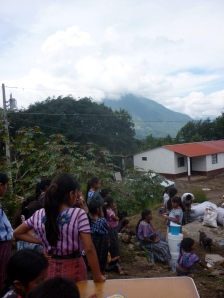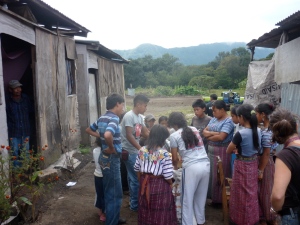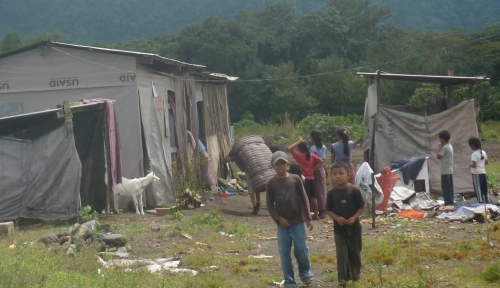Jess here, with another update from Panajachel. In an area plagued by natural disasters, the story goes on long after it fades from headlines. A couple of weeks ago, Steph and I got the opportunity to go on a delivery run with some of the Mayan Families staff. We were bringing much-needed food, bedding and water filters to a town of emergency housing erected by the government in the wake of a terrible tormenta (storm). The surprising part about this story: these weren’t victims of recent tormenta Agatha – these were people who lost their homes five years ago to huracán Stan (hurricane Stan). The temporary town, called Chuk Muk, consisted of clusters of identical cinderblock and tin houses tucked far away on volcán San Pedro (San Pedro Volcano), reachable only by a small, weather dependent access road.
Rebuilding after a disaster takes much more than just putting up some houses, though. While tourism drives the economy in Pana, that industry doesn’t touch the rural surrounding areas, where many families must scrape by without even one steady source of income. Many in these towns rely on agricultura (agriculture), and when disasters strike, crops are often destroyed along with houses and property. This means that families lose their source of income along with their homes and possessions, making it incredibly difficult to get back on their feet.
Many of the people we encountered in Chuk Muk live on the brink: there’s not enough food, clothes are scarce, shoes are a luxury. That’s why a program that Mayan Families began as just a student sponsorship program has evolved into so much more. A sponsored education will only go so far if a child and family are starving, so Mayan Families and their sponsors do their best to make sure that students and their families have food, water filters, small mattresses, or other víveres (basic provisions), though it is not required.
The organization needed to manage and distribute víveres is far more logistically complex than I ever imagined. The Mayan Families staff didn’t miss a beat, springing into action as soon as we arrived to organize both supplies and the crowd of families that had started to form. The students send their padrinos (godparents/sponsors) una carta (letter), un dibujo (drawing), and a copy of their most recent report card (to show they are attending class). Then they get their photo snapped and head over to the food distribution table, where they pick up anything else their sponsor may have given.
Things were definitely on the chaotic side: distributing food while managing hordes of small children, trying to get report cards, pictures, legible letters, plus photos, all while struggling to decipher a fair amount of Tz’utujil (the indigenous Mayan language of the area, which even indigenous Mayan Families staff members don’t speak) certainly made for an interesting morning. But the Mayan Families staff was beautiful in action; they were even armed with laminated lists of all the students with photos, full names, and student ID numbers.
Steph and I helped out where we could, mainly shepherding children and collecting letters. At the end of the day, there were still some víveres left for families who lived too far away to come pick them up. Racing against the afternoon rain, we loaded up la camión (truck) and headed to deliver the supplies. This one gave a whole new meaning to the term “shanty town.” With corrugated roofs and walls of nothing but tarp bearing the name USAID, these were more tents than houses. Here, we delivered food to a family of about 10 people all living in one such shack. Housing such as this provides serious insight into just why heavy lluvias (rains) and derrumbes (mudslides) cause such severe damage in this area. Just as the big bad wolf didn’t have much trouble blowing down the house of straw, a derrumbe makes quick work of a tarp shack. A brick (or block) house stands a much better chance.
As we piled back into la camión and prepared to head home, I realized how much my philosophy on aid had shifted. It’s tempting to think that implementing a self-sufficient system is simple – send in donations, promote education, and things should improve in a few years. But when families lose everything – homes, possessions, livelihoods – every year or two, the needs are much more basic. Yes, if you teach a man to fish, he’ll eat for a lifetime – unless his home, land, and fishing pole, as well as those of his neighbors, just got washed away in a mudslide. In that case, his wife and kids just need to not starve. That is one of the most important roles that Mayan Families fills so well: getting the basics where they need to go. You begin by keeping a family afloat, thus allowing a student to go to school instead of work. It’s not always logistically easy, but it’s crucial if you hope to have a better system eventually in place.
Over the next few weeks, we’ll be helping Mayan Families organize their Family Aid program to better meet these sorts of needs. Stay tuned as we begin to meet and profile these families!
Rebuilding after a disaster takes much more than just putting up some houses, though. While tourism drives the economy in Pana, that industry doesn’t touch the rural surrounding areas, where many families must scrape by without even one steady source of income. Many in these towns rely on agricultura (agriculture), and when disasters strike, crops are often destroyed along with houses and property. This means that families lose their source of income along with their homes and possessions, making it incredibly difficult to get back on their feet.
Many of the people we encountered in Chuk Muk live on the brink: there’s not enough food, clothes are scarce, shoes are a luxury. That’s why a program that Mayan Families began as just a student sponsorship program has evolved into so much more. A sponsored education will only go so far if a child and family are starving, so Mayan Families and their sponsors do their best to make sure that students and their families have food, water filters, small mattresses, or other víveres (basic provisions), though it is not required.
The organization needed to manage and distribute víveres is far more logistically complex than I ever imagined. The Mayan Families staff didn’t miss a beat, springing into action as soon as we arrived to organize both supplies and the crowd of families that had started to form. The students send their padrinos (godparents/sponsors) una carta (letter), un dibujo (drawing), and a copy of their most recent report card (to show they are attending class). Then they get their photo snapped and head over to the food distribution table, where they pick up anything else their sponsor may have given.
Things were definitely on the chaotic side: distributing food while managing hordes of small children, trying to get report cards, pictures, legible letters, plus photos, all while struggling to decipher a fair amount of Tz’utujil (the indigenous Mayan language of the area, which even indigenous Mayan Families staff members don’t speak) certainly made for an interesting morning. But the Mayan Families staff was beautiful in action; they were even armed with laminated lists of all the students with photos, full names, and student ID numbers.
Steph and I helped out where we could, mainly shepherding children and collecting letters. At the end of the day, there were still some víveres left for families who lived too far away to come pick them up. Racing against the afternoon rain, we loaded up la camión (truck) and headed to deliver the supplies. This one gave a whole new meaning to the term “shanty town.” With corrugated roofs and walls of nothing but tarp bearing the name USAID, these were more tents than houses. Here, we delivered food to a family of about 10 people all living in one such shack. Housing such as this provides serious insight into just why heavy lluvias (rains) and derrumbes (mudslides) cause such severe damage in this area. Just as the big bad wolf didn’t have much trouble blowing down the house of straw, a derrumbe makes quick work of a tarp shack. A brick (or block) house stands a much better chance.
As we piled back into la camión and prepared to head home, I realized how much my philosophy on aid had shifted. It’s tempting to think that implementing a self-sufficient system is simple – send in donations, promote education, and things should improve in a few years. But when families lose everything – homes, possessions, livelihoods – every year or two, the needs are much more basic. Yes, if you teach a man to fish, he’ll eat for a lifetime – unless his home, land, and fishing pole, as well as those of his neighbors, just got washed away in a mudslide. In that case, his wife and kids just need to not starve. That is one of the most important roles that Mayan Families fills so well: getting the basics where they need to go. You begin by keeping a family afloat, thus allowing a student to go to school instead of work. It’s not always logistically easy, but it’s crucial if you hope to have a better system eventually in place.
Over the next few weeks, we’ll be helping Mayan Families organize their Family Aid program to better meet these sorts of needs. Stay tuned as we begin to meet and profile these families!










No comments:
Post a Comment